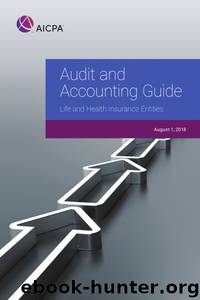Audit and Accounting Guide: Life and Health Insurance Entities 2018 (AICPA Audit and Accounting Guide) by AICPA

Author:AICPA [AICPA]
Language: eng
Format: epub
ISBN: 9781945498510
Publisher: Wiley
Published: 2018-10-25T16:00:00+00:00
Securities Lending Transactions 6
10.28 Life and health insurance entities may also lend debt securities (referred to as securities lending ) 7 or enter into other agreements such as repurchase agreements (repos), reverse repurchase agreements (reverse repos), or dollar repurchase and dollar reverse repos. Those kinds of transactions are generally short term in nature, ranging from 1 to 30 days; however, longer terms are possible. When a debt security is loaned, collateral consisting of cash, cash equivalent, or both is pledged and maintained in an escrow account. If the collateral is cash, the transferor typically earns a return by investing that cash at a rate higher than the rate paid or rebated to the transferee. If the collateral is other than cash, the transferor typically receives a fee. Because of the protection of collateral (typically valued daily and adjusted frequently for changes in the market price of the securities transferred) and the short terms of the transactions, many securities lending transactions do not pose significant credit risks on either party. However, the parties may be subject to other risks, such as interest rate and liquidity risks.
10.29 U.S. generally accepted accounting principles. Repurchase agreements and securities lending transactions are required to be evaluated under each of the conditions in FASB ASC 860-10-40-5 for derecognition. Repurchase agreements and securities lending transactions that do not meet all the conditions in FASB ASC 860-10-40-5 should be treated as secured borrowings.
10.30 However, FASB ASC 860-30-25-7 states that many securities lending transactions are accompanied by an agreement that entitles and obligates the transferor to repurchase or redeem the transferred assets before their maturity. FASB ASC 860-10-40-24 requires that an agreement that both entitles and obligates the transferor to repurchase or redeem transferred assets from the transferee maintain the transferor’s effective control over those assets under FASB ASC 860-10-40-5(c)(1), and the transfer is therefore to be accounted for as a secured borrowing, if and only if all of the conditions in FASB ASC 860-10-40-24 are met. Those transactions should be accounted for as secured borrowings, in which either cash or securities that the holder is permitted by contract or custom to sell or repledge received as collateral are considered the amount borrowed, the securities loaned are considered pledged as collateral against the cash borrowed and reclassified as set forth in FASB ASC 860-30-25-5(a), and any rebate paid to the transferee of securities is interest on the cash the transferor is considered to have borrowed.
10.31 FASB ASC 860-30-25-8 states that the transferor of securities being loaned accounts for cash received in the same way whether the transfer is accounted for as a sale or a secured borrowing. The cash received should be recognized as the transferor’s asset — as should investments made with that cash, even if made by agents or in pools with other securities lenders — along with the obligation to return the cash. If securities that may be sold or repledged are received, the transferor of the securities being loaned accounts for those securities in the same way as it would account for cash received.
Download
This site does not store any files on its server. We only index and link to content provided by other sites. Please contact the content providers to delete copyright contents if any and email us, we'll remove relevant links or contents immediately.
Harry Potter and the Goblet Of Fire by J.K. Rowling(3046)
Never by Ken Follett(2884)
Shadow of Night by Deborah Harkness(2719)
Ogilvy on Advertising by David Ogilvy(2683)
Zero to IPO: Over $1 Trillion of Actionable Advice from the World's Most Successful Entrepreneurs by Frederic Kerrest(2398)
The Man Who Died Twice by Richard Osman(2300)
Machine Learning at Scale with H2O by Gregory Keys | David Whiting(2293)
Book of Life by Deborah Harkness(2263)
How Proust Can Change Your Life by Alain De Botton(2261)
My Brilliant Friend by Elena Ferrante(2224)
0041152001443424520 .pdf by Unknown(2220)
The Tipping Point by Malcolm Gladwell(2205)
How to Pay Zero Taxes, 2018 by Jeff A. Schnepper(2100)
Will by Will Smith(2043)
Purple Hibiscus by Chimamanda Ngozi Adichie(1982)
Hooked: A Dark, Contemporary Romance (Never After Series) by Emily McIntire(1965)
Borders by unknow(1786)
Rationality by Steven Pinker(1765)
Daughter of Smoke and Bone by Laini Taylor(1744)
